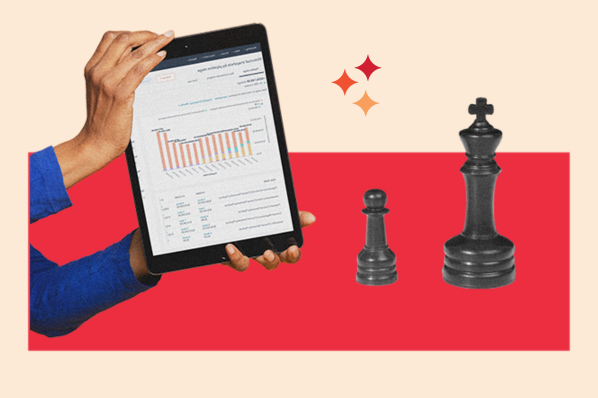More sales can mean more revenue and a bigger profit for your business.

However, as sales numbers grow, companies pass the point of being able to fulfill every order as soon as it's made. The result is what’s known as a “sales backlog."
Sales backlog is unavoidable. No matter how good your inventory management processes are, it’s impossible to fill all demands instantly.
But, a sales backlog isn’t necessarily negative. While it’s ideal to fill customer orders as quickly as possible, a healthy backlog shows that your product or service is in-demand, It also suggests that your company is seeing steady growth.
The caveat? If your sales backlog gets too big, it can lead to customer frustration, canceled orders, and -- ultimately -- lost revenue. On the other hand, if your backlog abruptly shrinks, it could be an indication of reduced demand or highlight issues with your overall process.
In this piece, we’ll tackle what sales backlog is, why it matters, and how you can calculate it. If you're already entering a backlog, we'll also show you how to manage it.
The Definition of Sales Backlog
Sales backlog refers to when the number of orders your company has taken but hasn’t yet completed. It is common in growing businesses and can indicate a higher demand for a product.
Aside from high demand, task backlog in other areas of your business -- such as your production line or accounts payable department -- can also be causing a backlog. For example, unexpected downtime in a production line can cause a backlog, as well as difficulty with suppliers.
The Importance of a Sales Backlog
While a backlog could mean your product is in high demand, you should still pay close attention to how big it gets and take steps to ensure customers aren’t waiting too long for their orders. As a business person, it's important to know which types of sales backlog you're dealing with.
Measuring sales backlog helps you assess company growth over time while determining when sales backlog becomes a problem.
Consider a business with the capacity to process 100 orders per week. When their brand initially launches and their product isn’t well-known or in-demand, they’ll likely have no problem meeting order targets every week. As their reputation grows and sales increase, they’ll begin to exceed their maximum capacity each week.
The challenge? While a steadily-growing backlog may indicate increasing demand, it can also point to problematic internal processes.
Let’s say that in our example above, the company has a sales backlog of 10 orders per week. One possibility is that they’re receiving 110 orders per week while their processing capacity remains at 100 percent, resulting in a steady backlog of 10 orders each week.
There’s another possibility that could lead to the same outcome: Diminished processing capacity. If fulfillment ability drops from 100 down to 90, taking 100 orders per week will produce the same backlog without the commensurate growth.
As a result, it’s not only critical to measure sales backlog but determine its source. If processes rather than purchases are responsible for the increasing value, this indicates a need to improve capacity planning and ensure fulfillment targets are met.
How to Calculate a Sales Backlog
Sales backlog is typically expressed as a ratio that compares daily, weekly or monthly order totals with order processing capacity. The higher the number, the smaller your backlog.
Sales backlog ratios are often shown in units or dollars depending on the needs of the organization. It’s also worth noting that, while backlog data may be shared with stakeholders or potential investors, it’s usually not disclosed publicly.
The simplest way to find a sales backlog ratio is by dividing the number of backlogged orders by the number of sales in a given time. Ideally, this is reported in days or weeks to provide more granular data about sales backlog.
Here’s what it looks like:
Sales backlog = Backlog of orders/Total Sales
Let’s use some numbers from our business in the example above. If they make 110 sales per week but have a 10 order backlog in the same period, the formula looks like this:
Sales backlog = 10/110
As a ratio, this is 0.09:1, which means that for every order, 0.09 orders are backlogged. If this number trends up over time while capacity stays the same, more orders are backlogged. If it trends down, total order numbers are falling and fulfillment is “catching up” to demand. While this is positive for customers in the short term, it’s not great for brands over time.
Ultimately, if businesses are only filling backlogs, that means they have no new sales and revenues will quickly decline.
Managing a Sales Backlog
Managing sales backlog effectively means understanding what the backlog ratio represents and how it impacts business operations. While initial backlog growth is generally positive, steady revenue combined with customer fulfillment will increase your company’s value.
Remember that unbridled backlog growth poses a problem. If backlogs continue to increase month over month — from 0.09 to 0.2 to 0.5, for example — it means customers are waiting longer and longer to get their orders. Eventually, consumers will get frustrated enough to cancel these orders and potential profit will be lost.
Balance your backlog with fulfillment rates
Best-case backlog management means finding a sweet spot between demand and capacity that keeps consumers happy while still growing your business.
Backlog management tactics might include adding new physical processing capacities or increasing the efficiency of specific processes — in this case, a decrease in sales backlog would be intended and effective. It’s also possible to temporarily inflate sales backlog with limited-time sales events or discounts, which can then be brought down to more stable levels over time.
Back(log) in Business
Sales backlog is a critical metric to help measure and manage business success. While not enough in isolation to drive steady revenue over time, understanding and managing this metric as it relates to total capacity and sales volume can help deliver sustainable success over time.






![How to Develop a Strategic Plan for Business Development [Free Template]](https://blog.hubspot.com/hubfs/Copy%20of%20Featured%20Image%20Template%20Backgrounds-2.png)




